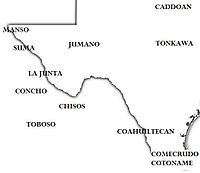Manso people
Traveling up the Rio Grande in search of the Pueblo Indians, Espejo encountered a people he called Tampachoas below El Paso.
They seemed to have lived along the Rio Grande from present-day El Paso northward to Las Cruces, New Mexico and in the nearby mountains.
Onate and his large expedition forded the Rio Grande near Socorro, Texas assisted by 40 "manxo" Indians.
In 1663, a Spaniard wrote of them, "The nation of Manso Indians is so barbarous and uncultivated that all its members go naked and, although the country is very cold, they have no houses in which to dwell, but live under the trees, not even knowing how to till the land for their food.
But they were described somewhat favorably as "a robust people, tall, and with good features, although they take pride in bedaubing themselves with powder of different colors which makes them look very ferocious.
The people were of minor concern until the 1680s, when the survivors of the Pueblo Revolt in New Mexico took refuge in the new settlement of El Paso.
On March 14, 1684, friendly Tiwa and Piro told the Governor Domingo Jironza Petriz de Cruzate of a Manso plot to kill all the Spaniards in El Paso.
In November, the Spanish garrison of 60 men, plus friendly warriors, attacked a gathering of hostile Indians whom they suspected of planning their own revolt.
[6] In 1883, however, Adolph Bandelier found a dozen families of Manso living across the Rio Grande from El Paso.

